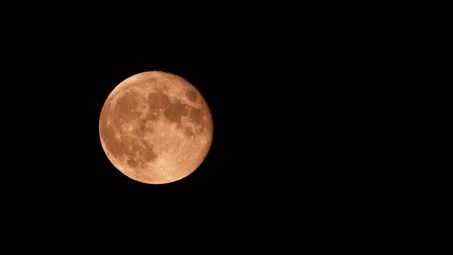A supermoon is a full moon (or a new moon) that nearly coincides with perigee—the closest that the Moon comes to the Earth in its elliptic orbit—resulting in a slightly larger-than-usual apparent size of the lunar disk as viewed from Earth. The technical name is a perigee syzygy or a full Moon around perigee.

What else can I help you with?
Could a supermoon distory are atmosphere?
No, a supermoon cannot destroy our atmosphere. A supermoon is a natural phenomenon where the full moon appears larger and brighter in the sky due to its closer proximity to Earth, but it does not have any impact on the atmosphere.
How often does a supermoon occur?
A supermoon occurs about three to four times a year, depending on the lunar cycle. It happens when the full moon coincides with the moon's closest approach to Earth, known as perigee. This combination makes the moon appear larger and brighter in the sky. The exact frequency can vary based on the definitions and criteria used to define a supermoon.
How long does the supermoon last?
A supermoon typically lasts for just one night when the full moon coincides with its closest approach to Earth in its orbit. The moon appears larger and brighter than usual during this time.
When will we have our next supermoon?
The next supermoon is expected to occur on April 7, 2022. This event happens when a full moon coincides with the moon's closest approach to Earth in its orbit, making it appear larger and brighter in the sky.
Why was the moon big and red yesterday?
The moon appeared big and red yesterday because of a phenomenon called a "supermoon." A supermoon occurs when a full moon coincides with the moon's closest approach to Earth in its orbit, known as the perigee. The red hue often seen during a supermoon is due to the scattering of light through the Earth's atmosphere, similar to how a sunset or sunrise appears red.
Is a supermoon a full moon?
Yes, it is.
When is the best time to view the supermoon?
The best time to view the supermoon is when it is closest to the Earth, which typically occurs when it is full and at its perigee, or closest point in its orbit. This usually happens a few times a year, so keep an eye out for announcements on when the next supermoon will occur.
When is the best time to look for a supermoon?
The best time to look for a supermoon is when it is at its fullest and brightest, which typically occurs once a month when the moon is closest to Earth in its orbit.
Could a supermoon distory are atmosphere?
No, a supermoon cannot destroy our atmosphere. A supermoon is a natural phenomenon where the full moon appears larger and brighter in the sky due to its closer proximity to Earth, but it does not have any impact on the atmosphere.
Is the supermoon going to effect earth?
not in any noticable way
How big is the supermoon?
Well that depends how close the moon is to earth
How often does a supermoon occur?
A supermoon occurs about three to four times a year, depending on the lunar cycle. It happens when the full moon coincides with the moon's closest approach to Earth, known as perigee. This combination makes the moon appear larger and brighter in the sky. The exact frequency can vary based on the definitions and criteria used to define a supermoon.
What time does the supermoon come out on March 19 2011?
10:00
How long does the supermoon last?
A supermoon typically lasts for just one night when the full moon coincides with its closest approach to Earth in its orbit. The moon appears larger and brighter than usual during this time.
Why was the moon big and red yesterday?
The moon appeared big and red yesterday because of a phenomenon called a "supermoon." A supermoon occurs when a full moon coincides with the moon's closest approach to Earth in its orbit, known as the perigee. The red hue often seen during a supermoon is due to the scattering of light through the Earth's atmosphere, similar to how a sunset or sunrise appears red.
How long will the super moon last?
The most recent full supermoon occurred on May 7, 2020, and the next one will be on March 28, 2021. The one on November 14, 2016 was the closest full supermoon since January 26, 1948, and will not be surpassed until November 25, 2034. The closest full supermoon of the 21st century will occur on December 6, 2052. It will last for a while!
When will we have our next supermoon?
The next supermoon is expected to occur on April 7, 2022. This event happens when a full moon coincides with the moon's closest approach to Earth in its orbit, making it appear larger and brighter in the sky.
